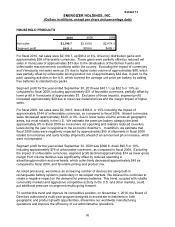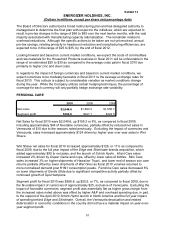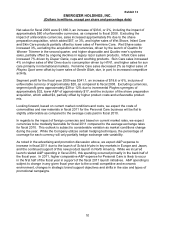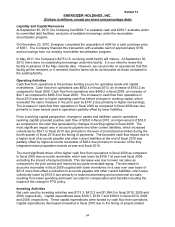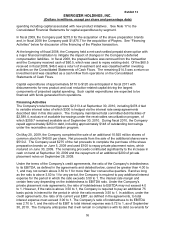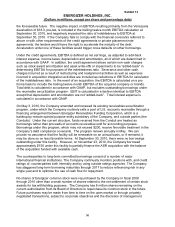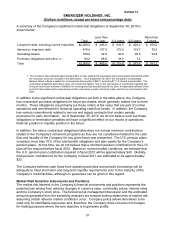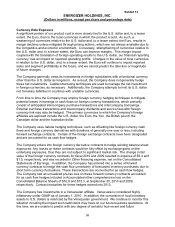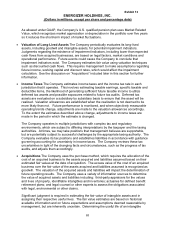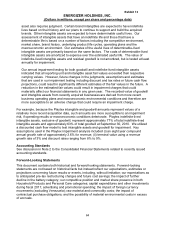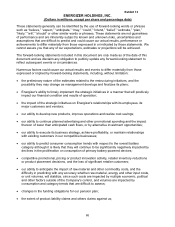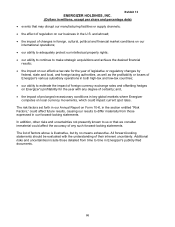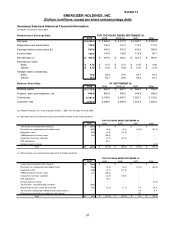Energizer 2010 Annual Report Download - page 67
Download and view the complete annual report
Please find page 67 of the 2010 Energizer annual report below. You can navigate through the pages in the report by either clicking on the pages listed below, or by using the keyword search tool below to find specific information within the annual report.
Exhibit 13
ENERGIZER HOLDINGS, INC.
(Dollars in millions, except per share and percentage data)
57
A summary of the Company’s significant contractual obligations at September 30, 2010 is
shown below:
Total
Less than
1 year 1-3 years 3-5 years
More than
5 years
Long-term debt, including current maturities 2,288.5$ 266.0$ 932.5$ 420.0$ 670.0$
Interest on long-term debt 476.4 107.9 172.5 119.7 76.3
Operating leases 108.9 22.9 30.6 20.5 34.9
Purchase obligations and other
(1)
94.2 68.8 18.0 7.4 -
Total 2,968.0$ 465.6$ 1,153.6$ 567.6$ 781.2$
1 The Company has estimated approximately $9.4 of cash settlements associated with unrecognized tax benefits within
the next year, which are included in the table above. As of September 30, 2010, the Company’s Consolidated
Balance Sheet reflects a liability for unrecognized tax benefits of $48.7, excluding $7.7 of interest and penalties. The
contractual obligations table above does not include this liability. Due to the high degree of uncertainty regarding the
timing of future cash outflows of liabilities for unrecognized tax benefits beyond one year, a reasonable estimate of the
period of cash settlement for periods beyond the next twelve months cannot be made, and thus is not included in this
table.
In addition to the significant contractual obligations set forth in the table above, the Company
has contractual purchase obligations for future purchases, which generally extend one to three
months. These obligations are primarily purchase orders at fair value that are part of normal
operations and are reflected in historical operating cash flow trends. In addition, the Company
has various commitments related to service and supply contracts that contain penalty
provisions for early termination. As of September 30, 2010, we do not believe such purchase
obligations or termination penalties will have a significant effect on our results of operations,
financial position or liquidity position in the future.
In addition, the above contractual obligations table does not include minimum contributions
related to the Company’s retirement programs as they are not considered material to the cash
flow and liquidity of the Company for any given fiscal year presented. The U.S. pension plans
constitute more than 70% of the total benefit obligations and plan assets for the Company’s
pension plans. At this time, we do not believe that a minimum pension contribution for the U.S.
plan will be required before fiscal 2012. Based on current market conditions, we estimate that
the U.S. pension plan contribution required in fiscal 2012 will be approximately $40. Globally,
total pension contributions for the Company in fiscal 2011 are estimated to be approximately
$22.
The Company believes cash flows from operating activities and periodic borrowings will be
adequate to meet short-term and long-term liquidity requirements prior to the maturity of the
Company's credit facilities, although no guarantee can be given in this regard.
Market Risk Sensitive Instruments and Positions
The market risk inherent in the Company’s financial instruments and positions represents the
potential loss arising from adverse changes in currency rates, commodity prices, interest rates
and the Company’s stock price. The following risk management discussion and the estimated
amounts generated from the sensitivity analyses are forward-looking statements of market risk
assuming certain adverse market conditions occur. Company policy allows derivatives to be
used only for identifiable exposures and, therefore, the Company does not enter into hedges
for trading purposes where the sole objective is to generate profits.





